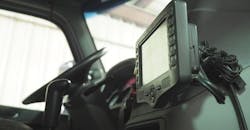Unlike the initial implementation of the electronic logging device (ELD) mandate in December 2017 and beginning of full enforcement in April 2018, there has not been nearly as much attention paid to the upcoming Dec. 16 deadline to permanently phase out older generation automatic onboard recording devices (AOBRDs).
Short haul drivers and others exempt from federal rules will not be required to use any electronic device to track hours of service (HOS). For all others, only ELDs can be used after the mid-December deadline.
ELD manufacturers told Fleet Owner that besides the need to retire AOBRDs, some fleets are discovering that what they thought was a verified device is not actually compliant. Others are realizing their ELDs may not have as long a lifespan as promised due to the planned sunsetting of 3G networks.
Earlier this year, Ray Martinez, head of the Federal Motor Carrier Safety Administration (FMCSA), expressed concern that the bulk of AOBRD users might wait until the final few months to make the change. During 2017, late ELD adoption created a capacity crunch for devices and installation.
Suppliers do not expect this transition to be quite as difficult, but some estimates still suggest two million devices need to be upgraded or replaced.
Eric Witty, vice president of product for Trimble’s Transportation Div., said that by this month, he believes most fleets will have at least started their transition process. Even if they are tempted to delay a transition until closer to the deadline, it could prove too disruptive to implement these changes during the holiday freight season.
Waiting until the last minute may leave “you scrambling to get processes in place at a time when business is picking up, and you don’t have the resources in place to migrate,” said Tom Cuthbertson, vice president of regulatory compliance at Omnitracs.
A similar message was shared by Mark Schedler, a senior editor with J.J. Keller & Associates. “Companies that delay planning and preparation are going to find the transition very difficult to complete training requirements, back-office and driver responsibilities, auditing electronic logs, and updating hours-of-service policies and procedures,” he said.
The first step for fleets is to make sure their specific ELD model is on FMCSA’s list of registered, self-certified devices. A driver found to be using a device not on the list could be cited for a violation.
All compliant ELDs are able to electronically transfer HOS data files to inspectors, if requested, via telematics (wireless web services and e-mail) and local transfer (Bluetooth and USB). They need to obtain data directly from the electronic control module, automatically record engine power status, vehicle motion status, and other information.
While those are the technical details, Denis Cody, a marketing director with Orbcomm, said that ELDs should make driving easier, not more complicated. By communicating with other software programs or apps, ELDs can help improve CSA safety scores, boost overall productivity, and lower operating costs.
Editor's note: This is the first in a week-long series ahead of the December deadline for fleets to end use of AOBRDs. Coming Tuesday: A look at the training required to ensure a successful transition.
About the Author
Neil Abt
Neil Abt is a former FleetOwner editor who wrote for the publication from 2017 to 2020. He was editorial director from 2018 to 2020.
